Teaching agility to the
Americans...
 Over the past few years, we've seen some European
handling techniques being introduced into the UK, but it's not a one-way street. We've been
exporting our own brand of agility with top handlers such as Greg Derrett and Anthony Clarke
who was recently been invited to take part, as an instructor, at two prestigious American
agility camps, one on each coast of the country. This is a compilation of his daily emails back
to the UK. Over the past few years, we've seen some European
handling techniques being introduced into the UK, but it's not a one-way street. We've been
exporting our own brand of agility with top handlers such as Greg Derrett and Anthony Clarke
who was recently been invited to take part, as an instructor, at two prestigious American
agility camps, one on each coast of the country. This is a compilation of his daily emails back
to the UK.
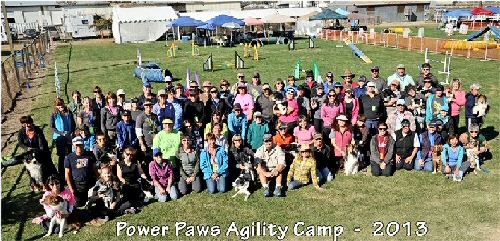
The official photo
Power Paws Camp 2013

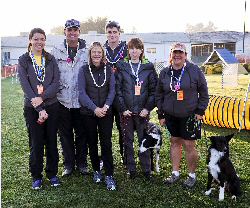 First there was Power Paws Camp, situated at the Nunes Agility Field,
Turlock, California, with 60 participants
and six instructors. This year the instructors included Nancy Gyes, Jim Basic, Tori Self,
Annie Pyle, Mia Grant and our own Anthony Clarke. Participants were split into six groups and
took part in one session with each instructor throughout the 3-day camp. First there was Power Paws Camp, situated at the Nunes Agility Field,
Turlock, California, with 60 participants
and six instructors. This year the instructors included Nancy Gyes, Jim Basic, Tori Self,
Annie Pyle, Mia Grant and our own Anthony Clarke. Participants were split into six groups and
took part in one session with each instructor throughout the 3-day camp.
Day 1
Each instructor is given a topic to teach for the three days and I had been given rear
crosses. My course set up allowed so many different rear cross situations, and it was great to
put my two groups through the drills.
This groups saw a mixture of breeds from
Papillons to Mountain dogs, Boston Terriers to Australian Cattle dogs. It was interesting to
work with so many different breeds. Several of the handlers had mentioned that they tended not to
use rear crosses and would use other handling moves to avoid them, so it was great to be
able to show these handlers an efficient and effective way to be able to execute a great rear cross.
I started talking about the three, easy and
effective rules which I follow when i am handling a rear cross scenario.
-
Set the Line – When the handler lines
their shoulders and body up to the line in which they want the dog to take.
-
Drive the line – When the handler moves
themselves along the line in which they want the dog to take.
-
Cross the line – When the handler moves
from being on one side of the dog to the other, to give the dog the information to change
direction onto the new line.
It was soon clear to see that these three
rules were working for the participants and the dogs were able to read what the handlers were
asking with no questions.
I love to see it it when all the
participants are able to utilise what they are learning and put it into practise and gain
brilliant results from it.
 Day
2 Day
2
Today started off a lot colder than yesterday and there was a blustering wind. When I first
arrived at the venue, I walked over to my ring to see students in my first group staking the
jumps ready for the session.
Due to the wind, it was difficult for the
students and participants to be able to hear me when i was teaching or speaking out in the
middle of the ring, so i was linked up to the head mic and sent on my way teaching.
I used the same set up and exercise today as
i did yesterday as I had new groups. One thing I just don't get bored with is helping students
and seeing
the clear improvements from al of them. Being able to help students to see and understand a
handling move better is a great feeling, and i love just how happy and excited some handlers
get.
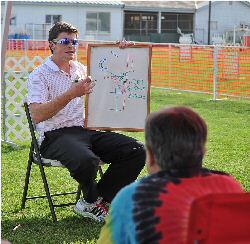 What did we cover in the session? What did we cover in the session?
For me, the main purpose of the rear cross session
is to make handlers aware of the efficient and effective lines they needed to be running to
be able to get the dogs to drive and execute the rear cross to the best of their ability. It's
quite common that we see handlers have very inconsistent line and ways of handling rear
crosses. The aim of my session were to give each handlers some easy guidelines to follow
to be able to remember for any rear cross they will be faced with on any course.
No matter what breed or size of dog you
have, a rear cross if one of the five basic handling moves in any handling system, and I
personally think is one of the hardest - if not the hardest - to keep technically and
theoretically correct.
Day 3
Today was the third and final day of Power Paws Camp 2013. The past three days have been
brilliant. I have met lots of new people and made lots of new friends at camp. I have really
enjoyed the whole experience and teaching in California for the first time.
The sun was shining and the wind had died
down today and all participants were full of energy and desire to learn. I sat for a while
talking with the groups during the theory part of my rear cross class. It was clear to
see that the whole camp experience had been a brilliant learning opportunity for so many new
handlers and young dogs. One of the great things about the camp the way it is run is that the
groups and encourage people to also meet new people and make new friends while learning and having
fun.
One of the main things I covered over the
past three days at camp was the theory of how handlers can improve the rear crosses behaviour
by following three very easy guidelines. These guidelines give you all the info you will need
to give your dog, to be able to execute a rear cross efficiently .
Tomorrow morning i hit the road across the
country to Boston
where i will be staying at Clean Run for a few days.
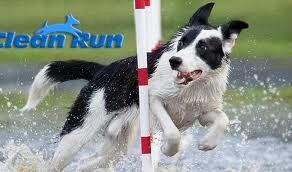
Clean Run Camp 2013
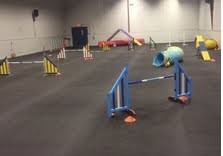 Clean Run has to be one of the best know
names in world agility for its range of top quality products, from toys and training aids to
equipment, DVD and books, and not to mention its agility magazine. Clean Run has to be one of the best know
names in world agility for its range of top quality products, from toys and training aids to
equipment, DVD and books, and not to mention its agility magazine.
Its always been an interest
of mine to see how companies like Clean Run are run behind the scenes, and I was lucky enough
to be invited out to Massachusetts, to teach a seminar for them. I visited the Clean run
offices and met all the staff and took a long look around the warehouse at all the products
they sell. It really was an interesting experience getting to know the process they operate.
Day
1
Today's seminar was with a great group of dogs and handlers, with a wide range of breeds
participating including Standard Poodles, Golden Retrievers and American Eskimos.
The indoor training facility is situated in the back of the Clean Run warehouse and is perfect
for training. The surface on the floor is rubber matting, and I have to say I think they are some
of the best mats I've seen on the floor in training centres.
Unlike Power Paws Camp, I had no specific
topic to give at the seminar, so my set up looked at combining handling skills.
It's becoming more and more common to see
the dog having to drive around a 270 or to the backside of a jump.
The drills saw handlers having to manoeuvre front crosses, rear crosses, serpentines and
threadles into either a large 270 or having to travel a significant distance to get the dog to
the back side of a jump.
 Day 2 Day 2
Day 2 at Clean Run delivered yet another talented group of dogs and handlers. Today's
sequences were slightly different to yesterday's due to several revisiting participants, but I
kept the same topic in mind for the group.
As I mentioned before, my concept was to
look at handling some
large 270s and getting to the backside of the jump. Today was no different, apart from we focus
of asking the dog to complete different handling manoeuvres after the completion of either the
270 or the backside.
We saw several drills where handlers had to
send the dog to the back side of a jump, then move into an efficient serpentine position before
moving off quickly to another area to be able to handle the next section of the sequence. Its
very common, where ever I present seminars anywhere in the world, many handlers seem to fall
into difficulty on course due to not moving to the next position on course and then falling
further and further behind of the dog, with no matter what handling system they use.
One of the things I wanted to see from participants was to keep moving on the active
acceleration line so the dog has information and movement supporting the next part of the
sequence. As a result of this efficient and effective movement we saw a drastic difference in
the dog's performance when cues were given in a timely fashion for the dog to be able to read.
All handling was very clear cut and
consistent with handlers moving efficiently and staying 100% connected to the dogs throughout
the course…. Well done guys, great session….
Looking forward to tomorrows group where we
will be looking at….International course challenges.....
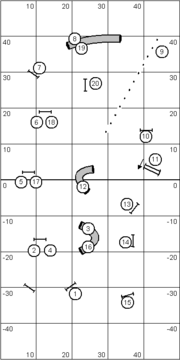 Day
3 Day
3
Today was International Course Handling. The courses I set were courses that I had run a while
back when preparing for the European Open, I found these courses had some great challenges and
really tested some great skills from both dogs and handlers.
Course one saw several different ways to be
able to handle the opening. We had an option of either front crossing jumps 5-6 and then again
6-7, or a front cross between jump 5 and 6 then serpentine jump7. Both options needed handlers
to be very efficient when leaving the dog as it entered the tunnel (number 3).
Again we saw options at the weave entry;
handlers could either rear cross the weaves or serpentine the exit to be able to get to jump10.
I love setting courses where there are
several different options to be able to handle the sequence or course.
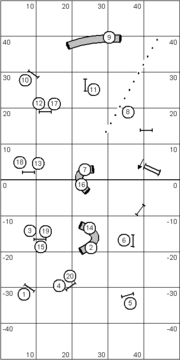 Course
2 again had several different handling options. There was the option of a front cross between
jumps 5 & 6 then to Serp #6 into the tunnel, or the option of a threadle from jump 5-6 then
again to take the dog away from the off course jump ahead, then into the tunnel on your right. Course
2 again had several different handling options. There was the option of a front cross between
jumps 5 & 6 then to Serp #6 into the tunnel, or the option of a threadle from jump 5-6 then
again to take the dog away from the off course jump ahead, then into the tunnel on your right.
There was also the decision to be made
between jump 13 and the tunnel of 14... front corss or rear corss?
Day 4
Today was my final day at Clean Run on this trip, and like the rest it was a brilliant day.
It was master's sequencing, so I set up smaller sequences that tested lots of different skills
for both dogs and handlers. The majority of the set ups were no longer that 6 obstacles but
each drill offered 2 options of handling. I made each participant work through both handling
options on each sequence as we were trying to test all skills.
It was such a pleasure to work with not only
great dog trainers and handlers but such a fun and friendly crowd; it really did make the trip
enjoyable and a great learning atmosphere.
First published 14 January 2014
|